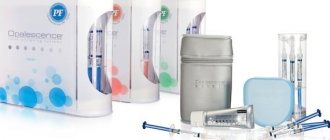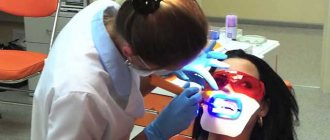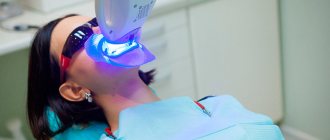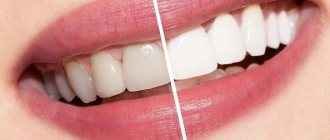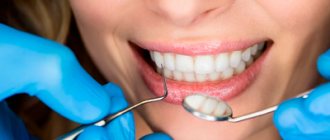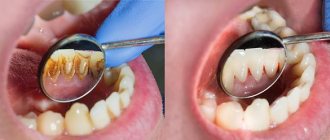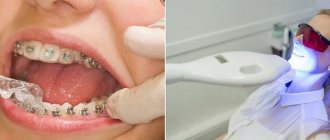Author of the article:
Soldatova Lyudmila Nikolaevna
Candidate of Medical Sciences, Professor of the Department of Clinical Dentistry of the St. Petersburg Medical and Social Institute, Chief Physician of the Alfa-Dent Dental Clinic, St. Petersburg
Over time, even the brightest smile becomes dull and acquires a more pronounced yellow tint; doctors call this phenomenon discoloration. It occurs from exposure to various organic and inorganic dyes that are found in food and tobacco. In addition, teeth can change color due to illness, medications, injuries and other factors. Restoring the shine of enamel and making it even brighter today is easier than it seems. A large selection of procedures makes it easy to find the best option, depending on the reasons for yellowing, the individual condition of the teeth and, of course, financial capabilities.
We will tell you about one of the most popular methods – teeth whitening using ultraviolet light. Let's discuss its advantages and disadvantages. Let's reveal the secrets of maintaining a snow-white smile after whitening.
Whitening principle
At the moment, there are two types of whitening - office (professional) and home. Both methods are actively used to improve the color of teeth, but professional whitening is more effective. On the other hand, any type of whitening is based on the same principles. The basis of the bleaching agent is hydrogen peroxide or carbamide. When decomposed, free radicals are released, namely atomic oxygen, which effectively destroys dyes and pigments that accumulate in dentin. The effectiveness of whitening depends on a number of factors, including the concentration of the active substance and the regularity of the procedure.
Causes of darkening of tooth enamel
In order for lamp teeth whitening to give the most positive results, you need to understand the reasons for the darkening of the enamel. In many cases, it will be enough to eliminate the negative impact factor so that the enamel acquires its natural shade.
The structure of dental tissue is quite porous. The enamel that covers the base of the tooth is translucent and cannot affect its overall color. The dark shade comes from dentin, which is visible through a thin layer of enamel. But why does it darken if the enamel itself is strong enough to allow negative factors to pass through? The reason lies in insufficient hygiene and love for solid food. Seeds, nuts, grilled candies, sour drinks and all similar products contribute to damage to the top layer of teeth, and then the dye easily penetrates into the tooth tissue, staining the dentin. The main factors contributing to the darkening of enamel:
- The most common reason is the consumption of products that contain a large concentrate of natural dyes. This could be: beets, blueberries or currants, cranberries or strawberries, coffee, strong tea, etc. In this case, careful hygiene will be the best way to get rid of the problem of darkening of teeth.
- The color of the enamel also changes in heavy smokers. The culprit in this case is the tar in the cigarette. As they settle on the surface of the tooth, they begin to gradually destroy tooth enamel. The best way out would be to give up cigarettes, but if the patient cannot do this, then it is worth paying more attention to hygiene procedures.
- The tooth may darken due to trauma during which the neurovascular bundle was damaged.
- The color also changes due to depulpation - when the nerve is removed from the tooth.
- Staining may occur due to the specific type of filling material used to seal the nerve canal.
- Progressive caries. At the initial stage of its development, this disease manifests itself only as small black dots, but if it is not cured in time, caries begins to progress, first destroying the enamel and then the dentin.
- Teeth may have congenital lesions, which are not classified as carious lesions. In addition to the dark color of the enamel, they differ in a different structure and shape.
- Excess fluoride in consumed water can provoke the development of a disease such as endemic fluorosis. When fluorosis begins to develop, dark areas, spots, or chalky streaks form on the teeth. All this leads to the destruction of enamel, and then dentin.
- Taking tetracycline antibiotics during pregnancy negatively affects the condition of the child’s teeth. The baby's teeth acquire a dark color during prenatal development.
The first two reasons for color changes are easily eliminated, but only in the first stages of development. In advanced situations, the whiteness of teeth cannot be restored. The problem is that the darkening becomes part of the healthy tooth and is now its natural shade.
Teeth whitening: harmful or not?
The procedure is part of cosmetic dentistry, but does not cease to be a medical service. That is why the answer to the question of whether teeth whitening in dentistry is harmful is obvious. When carried out correctly and using certified products and technologies, cosmetic teeth whitening does not pose a health hazard. This is the opinion of experts and researchers.
LED lamp and its advantages
The main advantage of using LED lamps for teeth whitening is that there is no threat to the patient’s health. This method has passed all tests and is considered one of the safest. The rays that are reproduced by the lamp pass through a special filter, the task of which is to neutralize the harmful effects of infrared waves and ultraviolet radiation. Thus, the enamel surface is exposed to a temperature no higher than 37.6ºC. In addition, other advantages of this procedure can be noted:
- Short time for the whitening procedure.
- The ability to get the desired result the first time.
- The gel used contains components that help reduce sensitivity to the procedure.
- The effectiveness of the system makes it possible to eliminate defects such as age-related darkening and darkening caused by fluorosis.
The disadvantage of the teeth whitening procedure with an LED lamp can be considered the cost of the session, the price of which varies between 7,000 and 20,000 rubles and a large list of contraindications.
Common myths about teeth whitening
The whitening procedure is surrounded by quite a lot of myths and not entirely correct opinions. Below are the most common ones.
- “Whitening harms tooth enamel.” Today there is practically no debate about whether whitening is harmful to tooth enamel. Does teeth sensitivity increase after whitening? Yes. Does enamel deteriorate? No. Recent studies indicate that frequent whitening procedures can lead to demineralization of the enamel and a decrease in its protective functions (especially with a high concentration of the active substance). That is why experts carry out a remineralization procedure after bleaching, and also recommend avoiding cold and hot foods in the first days. However, it cannot be said that hydrogen peroxide destroys enamel. That is why this statement falls into the category of misconceptions.
- “Whitening results last a lifetime.” This is one of the most common myths associated with teeth whitening. If all recommendations are followed and supportive measures are taken, good teeth color can be maintained for many years, but over time it will still fade somewhat. Moreover, the statement that teeth can be whitened by 10-12 shades is also more of a marketing ploy than the truth. The exact figures depend on several factors, including the individual characteristics of the patients' teeth. In reality, lightening by 8 tones (even with in-office bleaching) is an almost ideal result.
- “Photobleaching is more effective than chemical bleaching.” Some people believe that activating a substance using an ultraviolet lamp allows you to achieve much better results, but this is not so. Of course, a lot depends on the manufacturer, but if we compare the top systems Zoom (photo whitening) and Opalescence (chemical whitening), they are approximately equal in terms of efficiency. This is confirmed by patient reviews.
- “Fillings and crowns can also be whitened.” Unfortunately, this is a myth. That is why the presence of many fillings and crowns (especially in the frontal area) is a limitation for whitening.
- “You don’t have to go to a dental clinic for whitening services.” Professional whitening is carried out only in a dentist’s office in specialized clinics, otherwise there is a risk of not only not getting the desired result, but also of developing a number of serious complications (burns, poisoning, and so on). Home whitening kits can be used outside of a clinic, but even then, it is recommended to consult with a specialist first.
How effective is the procedure?
This method of transforming a smile is considered one of the most effective. Dentists claim that one session can help lighten the enamel by 12 tones. However, it must be remembered that even a doctor cannot predict the result exactly, because each patient’s body reacts to such “cold bleaching” differently.
The effectiveness also depends on the initial tone of the teeth. Moreover, if your teeth have a grayish tint, achieving a snow-white color will be extremely difficult. The situation is exactly the same with teeth darkened as a result of taking tetracycline antibiotics, as well as due to the increased fluoride content in the patient’s body.
But, if the teeth have darkened due to smoking, or a large amount of coffee or tea consumed, then they may well turn white.
Dentists also note that there are several percent of people in the world whose teeth react poorly to any whitening methods and do not achieve good results when using ultraviolet light.
Recommendations after whitening
Features of caring for teeth and maintaining their “shape” depend on the type of whitening. Moreover, before the procedure it is necessary to carry out a number of preparatory manipulations.
- Examination of the oral cavity, X-ray examination and identification of possible contraindications. These include cancer, diabetes, allergies to ultraviolet radiation, and active dental diseases. Whitening is also contraindicated for pregnant women and people under 18 years of age.
- Professional oral cleaning.
- In-office whitening usually requires one procedure. After this, remineralizing therapy is carried out, which will restore the enamel after the procedure. To consolidate the results, a course of home whitening is prescribed, which can last up to a month. If the patient wants to undergo only a course of home whitening, he also needs to consult with a doctor, who will also help him choose the optimal system.
Clinical researches
Clinical studies have proven that regular use of professional toothpaste ASEPTA REMINERALIZATION improved the condition of the enamel by 64% and reduced tooth sensitivity by 66% after just 4 weeks.
Sources:
- Report on determining/confirming the preventive properties of toothpaste “ASEPTA PLUS” GENTLE WHITENING” Author: doctor-researcher A.A. Leontyev, head Department of Preventive Dentistry, Doctor of Medical Sciences, Professor S.B. Ulitovsky First St. Petersburg State Medical University named after. acad. I.P. Pavlova, Department of Preventive Dentistry
- Clinical and laboratory assessment of the influence of domestic therapeutic and prophylactic toothpaste based on plant extracts on the condition of the oral cavity in patients with simple marginal gingivitis. Doctor of Medical Sciences, Professor Elovikova T.M.1, Candidate of Chemical Sciences, Associate Professor Ermishina E.Yu. 2, Doctor of Technical Sciences Associate Professor Belokonova N.A. 2 Department of Therapeutic Dentistry USMU1, Department of General Chemistry USMU2
- Report on the determination/confirmation of the preventive properties of personal oral hygiene products “ASEPTA PLUS” Remineralization doctor-researcher A.A. Leontyev, head Department of Preventive Dentistry, Doctor of Medical Sciences, Professor S.B. Ulitovsky First St. Petersburg State Medical University named after. acad. I.P. Pavlova, Department of Preventive Dentistry
- Clinical studies of antisensitive toothpaste “Asepta Sensitive” (A.A. Leontyev, O.V. Kalinina, S.B. Ulitovsky) A.A. LEONTIEV, dentist O.V. KALININA, dentist S.B. ULITOVSKY, Doctor of Medical Sciences, Prof. Department of Therapeutic Dentistry, St. Petersburg State Medical University named after. acad. I.P. Pavlova
- The role of anti-inflammatory rinse in the treatment of periodontal diseases (L.Yu. Orekhova, A.A. Leontyev, S.B. Ulitovsky) L.Yu. OREKHOVA, Doctor of Medical Sciences, Prof., Head of Department; A.A. LEONTIEV, dentist; S.B. ULITOVSKY, Doctor of Medical Sciences, Prof. Department of Therapeutic Dentistry of St. Petersburg State Medical University named after. acad. I. P. Pavlova
- Report on determining/confirming the preventive properties of toothpaste “ASEPTA PLUS” COFFEE and TOBACCO Author: doctor-researcher A.A. Leontyev, head Department of Preventive Dentistry, Doctor of Medical Sciences, Professor S.B. Ulitovsky. First St. Petersburg State Medical University named after. acad. I.P. Pavlova, Department of Preventive Dentistry
- Report on determining/confirming the preventive properties of commercially produced personal oral hygiene products: Asepta toothpaste used in combination with Asepta mouthwash and Asepta gum balm Head. Department of PFS Doctor of Medical Sciences Professor S.B. Ulitovsky St. Petersburg State Medical University named after Academician I.P. Pavlova. Faculty of Dentistry. Department of Preventive Dentistry.
Amazing White system – advantages, features, indications
An innovative method of whitening tooth enamel, Amazing White occupies a leading position in the ranking of the best dental techniques aimed at restoring the snow-white color of tooth enamel. The technique is based on the use of a special gel containing an active substance - hydrogen peroxide, which effectively lightens the tooth crown without compromising the integrity of the tissue structure.
Why is everything not as fast, effective and cheap as they promise in advertising!
Advertisements for any whitening systems talk about the safety, painlessness, speed, efficiency and affordability of the procedure, but do not pay due attention to proper preparation for teeth whitening.
Proper preparation takes time and may require additional financial investment.
The better the condition of your teeth, the less time and money it will take you to prepare for whitening.
Regardless of which whitening system you choose, the correct preparation is:
- will ensure the safety of whitening for teeth enamel
- will reduce the risk of pain during and after the procedure
- will give maximum whitening effect
Prepare properly for whitening and you will not be disappointed with the results.

